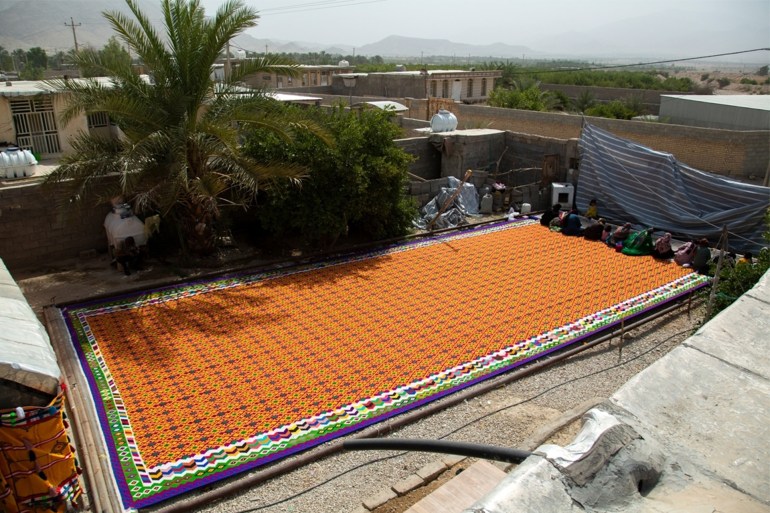With its bright colors and inscriptions that distinguish it from the rest of the world, Tehran announced that it has hand-woven in Fars Province (south of the country) a carpet with an area of 105 square meters, described as the largest in the world, and it is expected to be revealed during the 2022 FIFA World Cup Qatar.
With the start of the countdown to the FIFA World Cup hosted by Qatar, Doha continues to intensify its preparations for this huge event with the aim of coming up with an exceptional organization that has not happened before.
There are only a few months left that separate the football fans from the launch of the first and unique World Cup edition, which will be held for the first time in the Middle East and in an Arab country, and everyone is waiting for what Qatar will present to the world in the tournament, which will start next November, to conclude On the National Day of the State of Qatar, which falls on December 18, 2022.
The carpet is the product of the work of 7 master weavers and 3 assistants (Reuters)
In order to further dazzle the millions of fans coming to Doha next November, Qatar is preparing to receive the largest hand-woven carpet in the world that was woven in Iran, bearing the two logos of the FIFA World Cup Qatar 2022 and the name of the State of Qatar.
The carpet, which was announced a few days ago, was woven by hand in Fars Province, with an area of 105 square meters, and was described as the largest in the world.
"The carpet measures 7 meters by 15 meters," said Mohammad Jaafar Ebrahimi, head of Iran's local cultural heritage department.
Agence France-Presse: #Tehran announced that it has hand-woven a 105-square-meter kilim rug in Fars province in southern Iran, which has been described as the largest in the world.
pic.twitter.com/v8wNrUMZJe
— Sameer Al-Nimri (@sameer_alnamri) June 28, 2022
10 weavers
Ibrahimi added - in a press statement - that this rug is the product of the work of 7 main weavers and 3 assistants from the city of Qirokarzin in Fars Governorate, noting that the rug was implemented in response to an order from the State of Qatar.
The kilim (carpet) is used mainly in Turkey, Pakistan, Iran and Afghanistan. It is a type of oriental flat weaving with floral motifs, and its origins are traced back to the Asian nomads who used it in tents to protect themselves from the cold and damp.
In the same context, two Iranian artists from the city of Tabriz (northwest of Iran) finished weaving a carpet for the FIFA World Cup Qatar 2022.
The weaver of the carpet, Reda Lamaei, and its designer, "Jalali", used more than 300 colors, 2 million knots and dozens of designs in their luxurious painting, which measures 160 centimeters by 200 centimeters, and is scheduled to be displayed in Qatar during the 2022 World Cup.
🇮🇷 Iranian artists from the city of Tabriz finish weaving a carpet for the FIFA World Cup in Qatar
2022 During the # World Cup 2022 pic.twitter.com/cFdE1anejQ
— 🇮🇷 Moh Gharawi (@MohammadGharawy) June 26, 2022
6 months of design
The designer of this carpet said that its design took 6 months, and it used symbols, balls and emblems of 32 countries that hosted the World Cup from 1930 to 2022, as well as the "Al-Bayt" stadium in Qatar, which is scheduled to host the opening match of the World Cup in Qatar on November 21 next.
It is scheduled to display this artistic carpet to the public as one of the ancient Iranian handicrafts at the end of November 2022, coinciding with the establishment of the World Cup in Qatar.
Iranian handmade carpets (Ajami) are considered one of the finest types of carpets in the world, the most luxurious of its industries and an essential part of Iranian culture, and it is one of its most important non-oil exports.
Because of its unique elegance and beauty, which are given by the golden enamel that makes it.
Hand carpets are also an ancient heritage that reflects the social and cultural life and the diverse customs of peoples through different times, and preserves them as valuable pieces in museums, palaces and homes, because of their material and moral value to their owners.
It is noteworthy that Qatar - and as part of its endeavor to provide everything new in the next World Cup - plans to set up a thousand Bedouin-style tents in the desert for fans of the FIFA World Cup, with Doha seeking to attract 1.2 million visitors to attend the 28-day tournament.
The Supreme Committee for Delivery and Legacy - the organization responsible for organizing the first World Cup in the Middle East - reveals that the tents will overlook the desert scenes surrounding Doha, providing visitors with a real taste of camping in Qatar.
"We will give the fans the opportunity to live in the desert," she said, adding that there are also plans to set up prefabricated villages for the fans on empty spaces.

